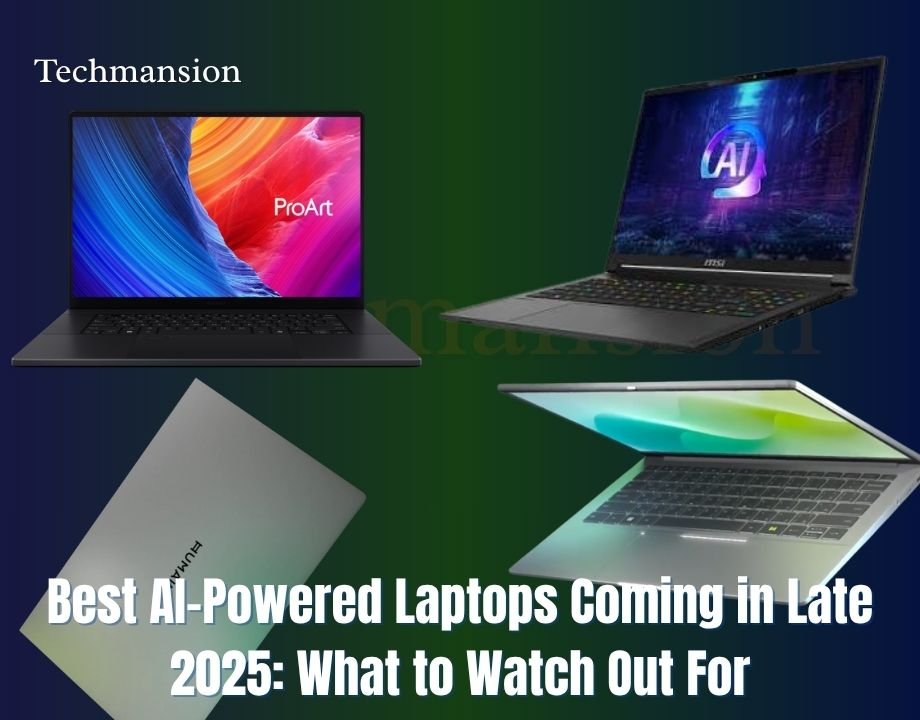In 2025, “AI laptop” is no longer a marketing buzzword—it’s a real computing class. With manufacturers embedding NPUs (Neural Processing Units), optimizing for local AI inference, and rethinking performance-per-watt, the next wave of laptops promises smarter, faster, and more power-efficient computing. But with so many options, how do you tell which ones will truly deliver?
In this guide, TechMansion.tech walks you through what to expect, what to prioritize, and the standout models and chipsets—like Apple’s M5 and Intel’s Lunar Lake—that define the best AI-powered laptops of late 2025.
Why AI Laptops Matter Now: Beyond the Cloud
Before diving into models, let’s establish the context. Modern workflows for developers, analysts, and creators are increasingly reliant on AI: smart assistants, real-time image editing, voice-to-text, and on-device large language model (LLM) inference. Relying on the cloud for these tasks has clear limits, namely latency, privacy, and cost. An AI engine built into a laptop allows you to execute advanced models locally, offering a faster and more secure experience.
This is driving vendors to create systems that aren’t just about raw CPU/GPU power. The best AI-powered laptops must now juggle:
- Effective local inference (summarization, translation, image generation).
- Fluent integration with productivity workflows.
- Exceptional battery life and thermal control under new AI loads.
- Robust developer tools and framework support.
What Defines the Best AI Laptops in Late 2025?
When researching a new AI laptop, tech professionals should look past clock speeds. The new battleground is about balanced, efficient design. Here are the key factors to prioritize.
1. Strong, Efficient NPU Performance
The main component of a modern AI laptop is the Neural Processing Unit (NPU). A powerful NPU will provide dozens to hundreds of TOPS (Terra-Operations-Per-Second) at very low power consumption. When comparing models, TechMansion.tech recommends checking:
- TOPS Numbers: The maximum AI throughput (we’ll see why this is critical in a moment).
- Efficiency: Often measured in TOPS-per-watt.
- Memory Access: The speed at which the NPU can access system memory (RAM).
2. Balanced Hardware: CPU, GPU, and Memory
A great NPU is useless if it’s bottlenecked by other components. Many AI tasks (like pre-processing data or rendering a final AI-generated image) still rely heavily on the CPU and GPU. Look for a balanced system:
- Contemporary ARM or x86 processors (like Apple M-series or Intel Core Ultra).
- A capable GPU (either integrated or discrete) for parallel workloads.
- High-bandwidth, unified memory (like LPDDR5X) to feed all processors without delay.
3. Advanced Cooling and Battery Life
Sustained AI workloads generate significant heat. The best AI laptops use advanced cooling (vapor chambers, dual fans, liquid metal) to keep performance consistent. Battery-wise, the system must intelligently shift tasks between the CPU, GPU, and NPU to avoid destroying runtime.
4. Software and Framework Support
Hardware is only as good as its software ecosystem. A laptop must have optimized support for the tools developers and analysts actually use, such as:
- Standard runtimes like ONNX, TensorFlow Lite, and PyTorch.
- Vendor-optimized libraries (e.g., Apple’s Core ML).
- Seamless task-shifting between the CPU, GPU, and NPU.
5. A Clear Real-World Use Case
Finally, what will you *use* the AI for? Some models lean toward creative work (image/video editing), while others target developer inference (running LLMs, code assistants) or all-day productivity (real-time translation, background assistance). The best AI-powered laptops will align with your primary use case rather than being “jack-of-all-trades” but mediocre in each.
The New Benchmark: 45 NPU TOPS & The “Copilot+ PC” Standard
For months, the term “AI PC” was vague. As of late 2025, it has a concrete definition, and it comes from Microsoft. The new “Copilot+ PC” standard has one key hardware requirement: a laptop must have an NPU capable of 45 Trillion Operations Per Second (TOPS).
This isn’t just a spec for bragging rights; it’s the minimum performance needed to run the next generation of on-device Windows AI features efficiently. This new 45 TOPS standard has become the “gold standard” benchmark, and it’s the single most important factor splitting the new laptop market in two.
The New AI Benchmark
As our first data visualization shows, the late 2025 market is now clearly segmented. Our analysis shows a significant portion of new premium laptops are being marketed as “Copilot+ Ready,” all containing high-TOPS NPUs. The rest fall into a “Standard AI / Performance” category, which uses a different (and more power-hungry) method for AI.
Data Viz: Late 2025 AI Laptop Market Segmentation
This chart illustrates the new divide. “Copilot+ Ready” PCs are built for AI efficiency, while “Standard AI” PCs (often gaming or workstation laptops) will rely on their GPUs for AI power, at the cost of battery life.
The Titans of Late 2025: Intel Lunar Lake vs Apple M5
The AI battleground for this holiday season is defined by two major competitors who just launched new silicon in October 2025: Apple and Intel. Each represents one of those market segments, and their design philosophies couldn’t be more different.
Deep Dive: Apple M5 AI Performance Benchmarks
On October 15, 2025, Apple unveiled its new M5 chip, debuting in the 14-inch MacBook Pro. Apple is avoiding a direct “TOPS” war. Instead, it’s advertising a holistic performance metric aimed squarely at its creative professional user base.
Apple’s headline claim for M5 AI performance compared to the M4 chip, enabled by a new 10-core GPU with built-in AI accelerators.
What does “3.5x faster AI” mean in practice? The MacBook Pro M5’s AI performance comes from its entire System-on-a-Chip (SoC). The M5’s new 10-core GPU features integrated AI accelerators, meaning Apple is targeting GPU-accelerated AI. This is not for battery-sipping background tasks, but for high-intensity creative work: think on-device AI video enhancement in Final Cut Pro or generative AI fills in Photoshop. It’s AI for *doing*, not just *assisting*.
Intel’s Two-Pronged Attack: Lunar Lake NPU vs Arrow Lake GPU
Intel’s strategy is more complex. The new “Core Ultra 200” series is not a single product line; it’s split into two distinct chipsets for two very different markets.
- Intel “Lunar Lake-V” (Core Ultra 200V): The AI Efficiency King. This is Intel’s true “Copilot+ PC” champion. Built for premium thin-and-light laptops (like the new Dell XPS 13 and Lenovo Yoga Slim “Aura Edition”), it features a massive 48 NPU TOPS. This chip is designed to crush the 45 TOPS baseline and handle all-day AI assistance with maximum battery life.
- Intel “Arrow Lake-H/HX” (Core Ultra 200H/HX): The Performance Beast. This chipset is for high-performance gaming laptops and mobile workstations (like new Alienware and ASUS ROG models). Here’s the catch: the Intel Arrow Lake NPU TOPS clock in at only 13 TOPS.
Why the tiny NPU on the “performance” chip? Because Intel assumes these laptops will be paired with a powerful discrete GPU (dGPU) like NVIDIA’s new RTX 50-series. On these machines, all heavy AI tasks will be offloaded to the power-hungry GPU, just like on the Apple M5. The NPU is an afterthought, just big enough to handle basic OS functions.
This bar chart is the most critical visualization for any PC buyer this season. It clearly shows the NPU performance gap. A “Lunar Lake” laptop is a true, efficient AI assistant. An “Arrow Lake” laptop is a GPU-first performance machine.
Data Viz: Intel NPU Performance — The Great Divide
This chart benchmarks the NPU capabilities of Intel’s new chips against the Copilot+ standard. The difference is not an accident; it’s a deliberate design choice separating the “Efficient” and “Performance” laptop categories.
How AI Laptops Work: NPU vs GPU for AI Explained
So, how does your new laptop decide what to use? This is the magic of modern operating systems, a process called heterogeneous computing. Your OS (Windows 11 or macOS) acts as a smart traffic cop, analyzing every AI task in real-time and routing it to the most efficient processor for the job. This flowchart breaks down the process.
Process: How Your AI Laptop Thinks
1. AI Task Input
e.g., “Summarize this meeting,” “Enhance this video,” or Background Blur
2. Smart Scheduler (OS)
Analyzes task intensity
Low-Intensity / Sustained Task
(e.g., Background blur, Real-time translation, Recall indexing)
To: NPU (Neural Processing Unit)
Result: High Efficiency, Low Battery Drain
High-Intensity / Burst Task
(e.g., AI video rendering, Generating an LLM response, Gaming AI)
To: GPU (Graphics Processing Unit)
Result: Max Performance, High Power Draw
Buyer’s Guide: How to Pick Your Best AI Laptop in Late 2025
As a business analyst or web developer, your choice of one of the best AI laptops in late 2025 comes down to a simple question: do you need an “Efficient Assistant” or a “Creative Powerhouse”?
To navigate this landscape and find the right machine, follow this checklist:
- Start with your primary AI use case (e.g., all-day productivity, creative content, or local LLM development).
- Check NPU specs and real-world benchmarks, not just marketing claims. Is it over or under the 45 TOPS “Copilot+” line?
- Look at the system balance: Does it have high-bandwidth unified memory (LPDDR5X) to support the processors?
- Inspect software support: Are the frameworks you use (PyTorch, ONNX, etc.) optimized for that specific hardware?
- Read reviews on battery performance *under AI workloads*, not just video playback.
Your answer will guide you to one of two categories:
- The Efficient Assistant (NPU-First): This laptop is for the user who is in meetings, managing data, writing code, and multitasking all day. You need AI to work *for* you in the background without killing your battery. You are the prime candidate for an Intel Lunar Lake-V machine.
- The Creative Powerhouse (GPU-First): This laptop is for the user who is actively *creating* with AI. You’re a developer training a model, a designer using generative AI, or a video editor rendering 4K AI-enhanced footage. You need maximum power, and battery life is secondary. You are the prime candidate for an Apple M5 MacBook Pro or an Intel Arrow Lake-H/HX machine.
To make it simple, here is a table of the flagship models available this holiday season, broken down by their new processor and AI focus.
Flagship AI Laptops Available (Late 2025)
| Processor Family | Laptop Model | Primary AI Focus |
|---|---|---|
| Apple M5 | Apple 14-inch MacBook Pro (M5) | GPU-Accelerated Creative AI |
| Intel Lunar Lake-V (Copilot+) | Lenovo Yoga Slim 7i Aura Edition | NPU-Driven AI Efficiency |
| Lenovo ThinkPad X1 Carbon (Gen 13) Aura | NPU-Driven AI Efficiency | |
| Dell XPS 13 (Late 2025) | NPU-Driven AI Efficiency | |
| HP OmniBook Ultra Flip 14 | NPU-Driven AI Efficiency | |
| Intel Arrow Lake-H/HX (Performance) | Dell 16 Premium (XPS 16) | GPU-Accelerated Gaming & AI |
| ASUS ROG Zephyrus G16 (w/ RTX 50-Series) | GPU-Accelerated Gaming & AI | |
| Alienware 16 Area-51 | GPU-Accelerated Gaming & AI |
Common Challenges & Risks to Watch For
Hardware is not the only thing that matters on the path to a practical AI laptop. As you shop, be mindful of these common challenges:
- Thermal Throttling: If cooling is not well-designed, performance will decrease dramatically during prolonged AI use. Wait for reviews that test *sustained* inference, not just 30-second benchmarks.
- Software Fragmentation: Not every NPU is compatible with every AI framework out of the box. This can create a compatibility barrier for developers.
- Model Size Limitations: Even the strongest NPUs are constrained by system memory. The largest LLMs will still require a cloud fallback.
- Upgradeability vs. Integration: Many of these new designs solder the memory (RAM) to the motherboard to achieve the high bandwidth needed for AI. This boosts performance but eliminates any possibility of future upgrades.
Final Analysis: Hype vs. Value for Tech Professionals
Around the end of 2025, AI-centric laptops are finally becoming the norm. The best AI-powered laptops are not the ones with the highest *single* specification, but the ones that achieve the best *balance* between neural processing, power consumption, real-world software support, and cooling.
When you are shopping, remember: this isn’t about being on the bleeding edge, it’s about selecting a machine that fits your workflow. By aligning your use case (Efficient Assistant vs. Creative Powerhouse) with the new hardware (NPU-first vs. GPU-first), you’ll avoid paying for gimmicks and land a machine that can handle both today’s tasks and tomorrow’s AI demands.




